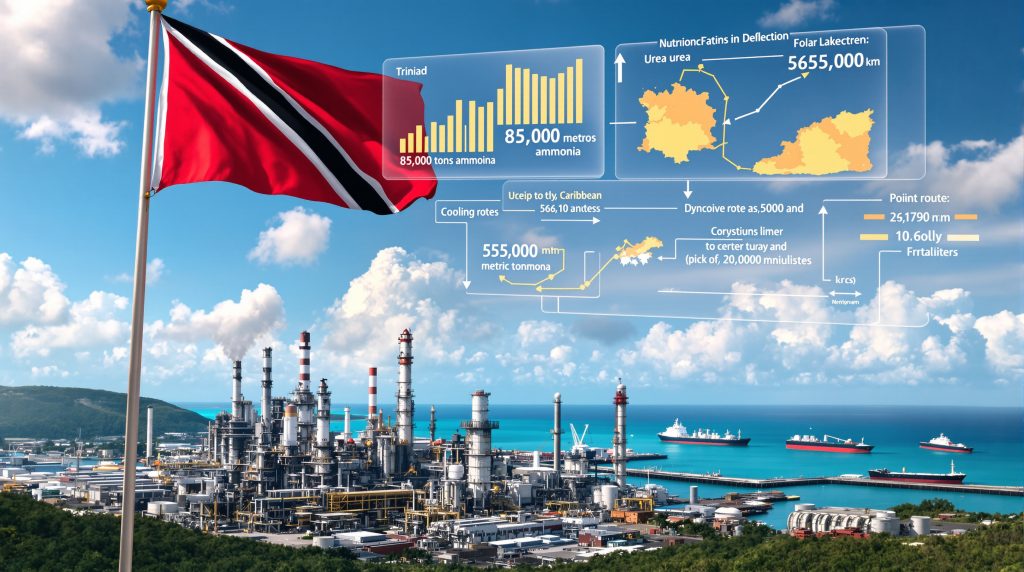Caribbean Natural Gas Crisis Forces Strategic Withdrawal
Nutrien to shut down Trinidad nitrogen operations at Point Lisas facility reflects deeper structural challenges plaguing the Caribbean petrochemical sector. The company initiated controlled closure procedures on October 23, 2025, citing two critical operational barriers that have undermined profitability over time.
Port access restrictions imposed by Trinidad and Tobago's National Energy Corporation created persistent logistical bottlenecks that disrupted export scheduling and increased operational complexity. These infrastructure limitations compounded existing challenges in the region's aging industrial framework, making efficient product distribution increasingly difficult for nitrogen producers.
Declining Gas Reserves Threaten Industrial Viability
Trinidad's natural gas supply chain vulnerabilities expose fundamental economic pressures facing industrial users across the Caribbean. The nation's proven natural gas reserves declined dramatically from 18.3 trillion cubic feet in 2010 to approximately 11.2 trillion cubic feet by 2020, representing a 39% reduction that directly impacts manufacturing competitiveness.
Natural gas production peaked at 4.2 billion cubic feet per day in 2010 but fell to approximately 2.9 billion cubic feet per day by 2020. This 31% production decline forced Trinidad's National Gas Company to implement industrial curtailments during peak demand periods, creating supply reliability issues that undermined long-term operational planning for facilities like Point Lisas.
The economic viability threshold for ammonia production becomes increasingly challenging when input costs rise due to supply constraints. Furthermore, this situation reflects broader trends in commodity market volatility affecting energy-intensive industries. Modern ammonia facilities require consistent, competitively-priced natural gas to maintain profitability margins that justify continued operations against global competitors with more stable energy access.
Production Capacity Loss Creates Regional Supply Gap
The Point Lisas facility represented significant production capacity within the global nitrogen market, manufacturing approximately 85,000 metric tons of ammonia and 55,000 metric tons of urea monthly. These output levels translate to roughly 1,020,000 metric tons of ammonia and 660,000 metric tons of urea annually.
Within the global context, Trinidad's facility accounted for approximately 0.43% of worldwide ammonia production capacity, based on International Fertilizer Association data showing total global capacity near 235 million metric tons annually. While seemingly modest as a percentage, this production loss affects regional supply chains and pricing dynamics across Caribbean agricultural markets.
| Production Metrics | Monthly Output | Annual Equivalent |
|---|---|---|
| Ammonia | 85,000 metric tons | 1,020,000 metric tons |
| Urea | 55,000 metric tons | 660,000 metric tons |
| Combined nitrogen content | ~140,000 metric tons | ~1,680,000 metric tons |
The combined annual production equivalent of approximately 1.68 million metric tons represents substantial capacity that must be replaced through alternative sources or absorbed by increased utilisation at remaining facilities.
North American Operations Compensate for Caribbean Loss
Nutrien maintains confidence in meeting its 2025 annual nitrogen sales outlook of 10.7 to 11.2 million metric tons despite the Trinidad shutdown, relying on enhanced performance across its North American production network. This strategic rebalancing demonstrates the company's operational flexibility and geographic diversification advantages.
The company operates multiple nitrogen production facilities across Canada and the United States, including:
- Redwater, Alberta: 810,000 metric tons annual ammonia capacity
- Carseland, Alberta: 570,000 metric tons annual ammonia capacity
- Joffre, Alberta: 1,100,000 metric tons annual urea capacity
- Fort Saskatchewan, Alberta: Additional nitrogen production
- Lima, Ohio: US-based ammonia and urea manufacturing
- Borger, Texas: Strategic southern US production location
Industry capacity utilisation averaged approximately 77% globally in 2023, suggesting room for increased production at existing facilities without requiring new construction or major capital investments.
This spare capacity across Nutrien's continental operations enables the company to maintain customer commitments while optimising production efficiency at facilities with more favorable input costs and infrastructure access. However, the broader implications of such shutdowns reflect challenges similar to those discussed in Canada energy transition analyses.
Caribbean Industrial Decline Accelerates
Trinidad's manufacturing sector experienced notable contraction over the past decade, declining from approximately 7% of GDP in 2014 to roughly 5% by 2022. This trend reflects broader challenges facing Caribbean industrial operations, including energy supply constraints, infrastructure deterioration, and competitive pressures from more efficient global production centres.
The petrochemical sector's struggles mirror difficulties across multiple industries dependent on reliable, affordable natural gas supplies. Foreign investment withdrawals and facility curtailments have become increasingly common as operators reassess the economic viability of Caribbean operations against alternative locations with superior input availability.
Government policy responses have struggled to address fundamental infrastructure and energy supply challenges that undermine industrial competitiveness. Consequently, the lack of comprehensive solutions for natural gas supply security and port infrastructure modernisation continues hampering retention efforts for remaining industrial operations.
Regional Energy Infrastructure Requires Substantial Investment
Trinidad's industrial users face ongoing prioritisation challenges as upstream gas production continues declining. The competition for available natural gas supplies intensifies between electricity generation, industrial manufacturing, and export commitments, creating uncertainty that complicates long-term operational planning.
Energy security implications extend beyond individual facilities to affect the entire manufacturing ecosystem supporting petrochemical production. Supporting industries, transportation networks, and skilled workforce retention all suffer when anchor industrial operations become uneconomical.
Global Supply Chain Adjustments Target Alternative Sources
Caribbean agricultural markets face significant import dependency challenges as regional nitrogen production capacity shrinks. Island nations previously supplied by Trinidad operations must identify alternative sources, potentially increasing transportation costs and supply chain complexity for essential fertiliser inputs.
Atlantic trade route modifications become necessary as shipping patterns adjust to accommodate supply from different geographic origins. European and North American suppliers may increase market penetration opportunities in Caribbean territories previously served by closer regional production.
The logistics cost implications for end users vary significantly based on alternative supply source locations, shipping distances, and port infrastructure capabilities at destination markets. These factors influence agricultural input costs across the region's farming operations.
Competitive Positioning Favours Established Global Players
Major nitrogen producers worldwide are strategically positioned to capture market share previously served by Nutrien to shut down Trinidad nitrogen operations. Companies with flexible production networks and established distribution channels gain competitive advantages during supply transitions.
CF Industries Holdings operates approximately 9.6 million metric tons of annual ammonia capacity across facilities in the United States, Canada, and United Kingdom. The company's North American concentration provides advantages for serving Caribbean markets through established export channels.
Yara International maintains global operations with approximately 5.8 million metric tons of ammonia capacity and 7.2 million metric tons of urea capacity. Their diversified geographic presence enables responsive supply adjustments to emerging market opportunities.
OCI Global operates nitrogen facilities across multiple continents with total production capacity exceeding 8.1 million metric tons annually. Their strategic positioning in the Middle East, Europe, and Americas provides flexible sourcing options for displaced Caribbean demand.
The global nitrogen industry's 77% average capacity utilisation suggests sufficient spare capacity exists to absorb Trinidad's production loss without requiring new facility construction or major capacity expansions.
Asset Portfolio Optimisation Drives Strategic Focus
Nutrien's decision reflects broader asset portfolio optimisation strategies prioritising higher-return operations with superior input cost structures and infrastructure access. The company continues evaluating options for remaining Trinidad operations while focusing capital allocation toward North American facilities with competitive advantages.
Recent financial performance demonstrates the contrast between operations. Nutrien's Q3 2024 results showed total revenue of $6.5 billion with nitrogen segment operating earnings of $289 million from 2.8 million metric tons of production, highlighting the importance of operational efficiency across the production network.
Industry consolidation trends favour companies with geographically diversified, technically advanced facilities capable of maintaining competitiveness during commodity price cycles. The top 10 nitrogen producers increased their share of global production capacity from 38% in 2013 to 45% by 2023, reflecting ongoing market concentration.
Capital Reallocation Priorities Target Stable Regions
Investment strategies increasingly emphasise political stability, infrastructure reliability, and input cost predictability when evaluating facility locations. Caribbean operations face inherent challenges in these areas compared to established North American and European production centres.
Technology upgrade priorities for remaining facilities focus on energy efficiency improvements and production optimisation systems that reduce operational vulnerability to input cost fluctuations. Modern Haber-Bosch plants achieve energy efficiency of 28-32 gigajoules per metric ton compared to 40-50 gigajoules in older facilities.
Restart Scenarios Require Fundamental Changes
Nutrien indicated it will continue discussions with stakeholders regarding potential restart scenarios, though successful resumption would require addressing fundamental economic and infrastructure challenges. Natural gas supply reliability and competitive pricing represent essential preconditions for renewed operations.
Port access improvements through National Energy Corporation cooperation would be necessary to restore efficient export capabilities. The economic threshold analysis for restart scenarios must account for capital costs, competitive positioning, and long-term supply security guarantees.
Government incentive possibilities could potentially offset some operational disadvantages, though historical precedent suggests limited success for retention programmes that don't address underlying structural challenges. Infrastructure improvement commitments would require substantial public and private investment coordination.
Market condition changes favouring Caribbean production locations appear unlikely given global industry trends toward geographic concentration in regions with superior input cost structures and infrastructure reliability.
Frequently Asked Questions
How does this affect global ammonia pricing?
Short-term supply tightening effects may create modest upward pressure on global ammonia prices, though the impact remains limited due to spare capacity at alternative facilities. Regional price differentials could become more pronounced as Caribbean markets adjust to alternative supply sources with different transportation cost structures.
Market adjustment timeline expectations suggest Caribbean customers will complete supplier transitions within 6-12 months, after which pricing patterns should stabilise based on new supply chain configurations. In addition, the situation mirrors broader commodity market trends discussed in oil price crash analysis and reflects similar supply-demand dynamics.
What alternatives exist for Caribbean fertiliser supply?
Import source diversification options include North American producers with established export capabilities, South American facilities with Atlantic shipping access, and European suppliers expanding Caribbean market penetration. Regional production capacity assessment reveals limited alternative Caribbean-based sources.
Transportation cost comparisons favour suppliers with efficient port facilities and established shipping routes, potentially increasing total delivered costs for some Caribbean markets previously served by Nutrien to shut down Trinidad nitrogen operations.
Could other companies acquire the Trinidad facility?
Asset valuation considerations must account for the operational challenges that prompted Nutrien's withdrawal, including natural gas supply constraints and port access limitations. Potential acquirers would inherit these fundamental structural disadvantages without obvious solutions.
Strategic buyer identification focuses on companies with lower cost structures, different operational requirements, or alternative product mix strategies that might justify continued operations under current conditions. However, industry analysis suggests limited interest given the underlying economic challenges.
Long-term Supply Security Implications
Geographic risk diversification lessons from the Trinidad shutdown emphasise the importance of maintaining production capacity across multiple stable regions with reliable input supplies. Single-country exposure vulnerabilities become apparent when local conditions deteriorate unexpectedly.
Infrastructure dependency risk management requires ongoing evaluation of port access, transportation networks, and utility reliability at production locations. Political stability factors increasingly influence facility location decisions as companies seek to minimise operational disruption risks.
Furthermore, these challenges reflect broader patterns affecting energy-intensive industries, particularly in regions experiencing the type of transitions discussed in US tariffs impact on global supply chains.
Next-Generation Production Technologies Reshape Industry
Technology and efficiency improvements continue driving industry evolution toward more energy-efficient and environmentally sustainable production methods. Green ammonia production using renewable energy and electrolysis could reach 5-8 million metric tons annually by 2030, though this represents less than 5% of current global capacity.
Renewable energy integration possibilities for nitrogen production offer potential advantages in regions with abundant wind or solar resources, though current costs remain significantly higher than conventional natural gas-based production. These technological advances may eventually alter competitive dynamics between production regions.
The situation also connects to broader natural gas market dynamics explored in US natural gas forecast analyses, where supply security and pricing stability remain critical factors for energy-intensive manufacturing operations.
According to Nutrien's official announcement, the company will continue evaluating all options while maintaining focus on its core North American operations. Additionally, Trinidad's NewsDay reported that government officials are exploring potential solutions to address the underlying infrastructure challenges.
This analysis is based on publicly available information and industry data. Market conditions and company strategies may change, affecting the accuracy of forward-looking assessments. Investors should conduct independent research before making investment decisions.
Looking to Invest in Natural Gas and Industrial Materials Sectors?
Discovery Alert's proprietary Discovery IQ model delivers real-time notifications on significant ASX mineral discoveries, including energy and industrial materials opportunities that could benefit from shifting global supply dynamics like those affecting Caribbean nitrogen production. Begin your 30-day free trial today to identify actionable investment opportunities ahead of the broader market, powered by advanced AI technology that scans daily ASX announcements instantly.




